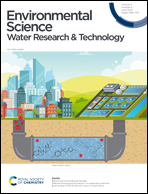Flocculation of livestock wastewater using cationic starch prepared from potato peels†
Abstract
A cationic starch flocculant was prepared from potato peel waste (PPW) for enhanced solid–liquid separation of livestock wastewater, thereby promoting the agricultural circular economy. The starch extracted from PPW was cationized by incorporating a cationic moiety onto the backbone of starch via etherification with (3-chloro-2-hydroxypropyl)trimethylammonium chloride (CHPTAC). Using response surface methodology, a cationic starch sample with a degree of substitution (DS) = 0.86 was obtained from optimized reaction conditions: 1 wt% starch, 0.124 M CHPTAC, 2.0 M NaOH, isopropanol solvent, 60 °C and 5 h. 1H NMR and FTIR confirmed the successful cationization of starch. A detailed analysis of the NMR spectra indicates that the substitution happened at all three OH groups of the anhydroglucose unit, and some of the proton peak assignments in the literature are mistaken. The DS = 0.86 sample was further studied for its flocculation performance. When used to treat undiluted swine and dairy wastewater (with high total suspended solid levels of 51.4 and 45.0 g L−1), despite a moderate suspended solid (SS) reduction (27.8 and 58.0%), the SS removal efficiency (72 and 162 mg SS per mg flocculant achieved at the optimal dosages of 200 and 160 mg L−1 for swine and dairy wastewater, respectively) was greater than that of commercial flocculant PAM and some other flocculants in the literature that were used to treat highly diluted livestock wastewater.



 Please wait while we load your content...
Please wait while we load your content...